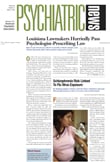Most sexual offenders have paraphilias or antisocial personalities and in many cases also have depression, bipolar disorder, or an impulse control disorder.
These findings come from a study conducted by Neal Dunsieth, M.D., an assistant clinical professor of psychiatry at Wright State University in Dayton, Ohio, and colleagues and are reported in the March Journal of Clinical Psychiatry.
“To our knowledge,” they noted, “ours is now the largest group of sexual offenders evaluated using structured clinical interviews for psychiatric disorders, personality disorders, and paraphilias.”
Their study included 113 convicted sexual offenders voluntarily participating in an 18-month, residential, sexual-offender treatment program in Columbus, Ohio, between 1996 and 2001. All were male, aged 18 years or older, and 35 years old on average. About two-thirds of the subjects were white, and one-third were African American. All were convicted of at least one sexual offense. None, however, admitted to a sexually sadistic murder.
Upon admission to the treatment program, all participants were evaluated with a number of structured clinical tools including the Structured Clinical Interview for DSM-IV Axis I Disorders, augmented with modules for DSM-IV impulse control disorders not elsewhere classified and sexual disorders; the Structured Clinical Interview for DSM-IV Axis II Disorders; a history of sexual and physical abuse; a history of psychotic, mood, anxiety, eating, substance use, impulse control, and paraphilic disorders in first-degree relatives; a review of medical and legal records and polygraph examinations.
Not surprisingly, 74 percent of sexual offenders were found to have a paraphilia, 56 percent met criteria for antisocial personality disorder, 28 percent met criteria for borderline personality disorder, and 25 percent met criteria for narcissistic personality disorder. More unexpectedly, however, many had other diagnoses. Fifty-eight percent had a mood disorder, 35 percent had bipolar disorder, 38 percent had an impulse control disorder, and 23 percent had an anxiety disorder. Moreover, 85 percent qualified, according to DSM-IV criteria, for a lifetime diagnosis of substance abuse disorder.
In addition, offenders with paraphilias were much more likely than other offenders to have mood, anxiety, and impulse control disorders. More than half of the subjects had been victims of sexual abuse themselves, while more than a quarter had been victims of incest.
The study did have some limitations, Dunsieth and his team noted. For example, no non-sexual-offender control group was used in the study, and investigators who diagnosed subjects for psychiatric disorders were not blinded to their sexual offenses. Nonetheless, Dunsieth told Psychiatric News, the results imply that clinical psychiatrists should “assess mental illness in sexual offenders and note a strong correlation between deviant sexual attraction [paraphilias] and an increased incident of mental illness.”
“Overall this is a very positive study,” Richard Krueger, M.D., medical director of the Sexual Behavior Clinic at New York State Psychiatric Institute, said in an interview. For one thing, he said, “it is very difficult to do this kind of study. Often departments of correction or parole are resistant to involvement in academic studies.” For another, he added, “they did a family history of sexual offenders, which is not often reported, and I think that is an important contribution.”
He agreed with Dunsieth that the study results “highlight the importance of a full psychiatric assessment of individuals involved with sexual crimes. Often they get plugged into sexual-offender programs without a psychiatric evaluation.”
“This is a welcomed study reminding us that the sexual-offender population is a heterogeneous group composed of multiple overlapping diagnostic subgroups,” Charles Smith, M.D., clinical director of the Whiting Forensic Division of the Connecticut Valley Hospital in Middletown, Conn., told Psychiatric News. “This diagnostic heterogeneity has serious implications for the design of social policy to ensure public safety by containing the behavior of known sexual offenders. Dunsieth and colleagues demonstrate very convincingly that subgroups of sexual offenders can be identified with divergent therapeutic problems and differential treatment concerns. It is a reasonable extrapolation of this work to envision treatment interventions and risk-reduction strategies tailored to, and optimized for, different sexual offender subgroups.”
“The study does offer hope,” Smith added, “that treatment of comorbid mental health conditions among some sexual offenders may be an effective approach to decreasing offender recidivism.”
The sexual offender treatment program on which this study was based and data collection for the study were financed by the Ohio Adult Parole Authority.
The study, “Psychiatric and Legal Features of 113 Men Convicted of Sexual Offenses,” is posted online for paid subscribers at www.psychiatrist.com/privatepdf/2004/v65n03/v65n0302.pdf. ▪
